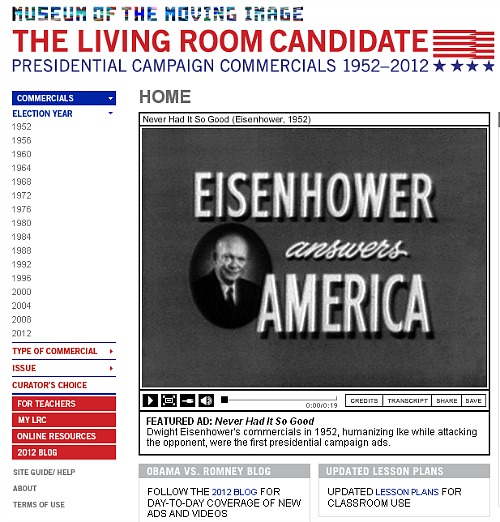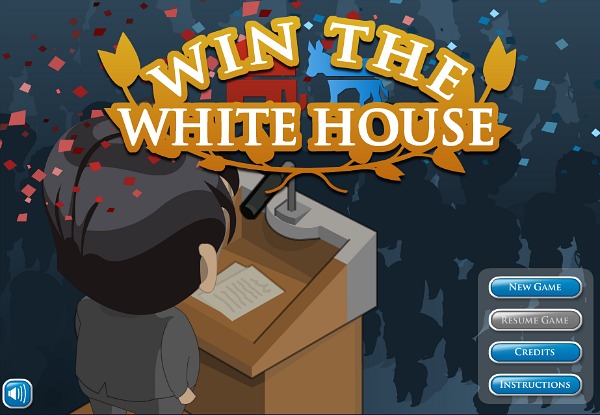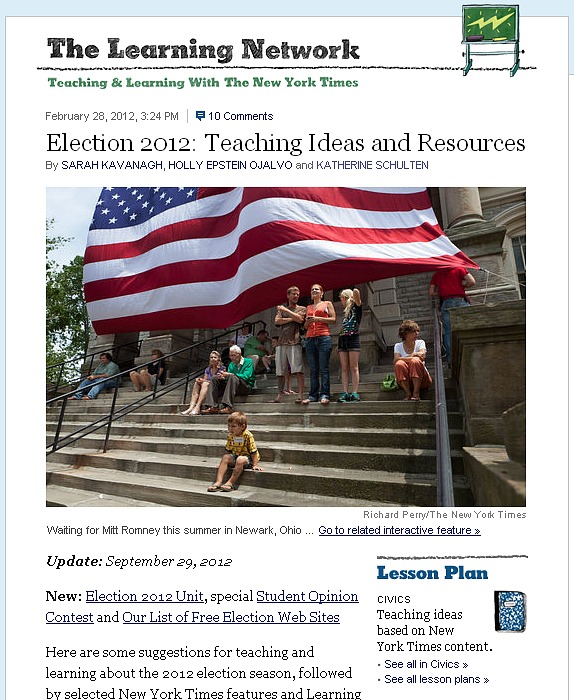
Detail from the the home page of “The Living Room Candidate.”
By Eric Langhorst
A school year with a presidential election is like a perfect storm for a social studies teacher. It’s a rare opportunity to teach around a topic that happens to be the focus of the entire nation. While teaching resources abound, the following are my picks for the best content to help you make the most of this teachable moment and get students engaged in the political process.
“The Living Room Candidate” is one of my favorite sites to help teach the campaign process. Here you can share with students presidential TV campaign ads from 1952 through the current 2012 election. Want to see how candidates have created ads based on the topic of taxes or war through the years? The search tool allows you to filter results by type of ad and general subject. Students can try their hand at creating their own ads using Living Room’s robust online video editing tool, which includes existing clips.
The electoral college is a difficult thing to understand, much less explain. But some powerful tools can help. My favorite for teaching the electoral college is “270 To Win” Graphics and an interactive map help students understand the mathematics behind the process. This site is a natural fit for an interactive whiteboard—students can step up and manipulate the map with the touch of their finger. Here, too, kids can view historical electoral college data on elections dating back to 1789 or see which states are considered swings states in 2012.
Want to let kids jump in and make some important decisions on the campaign trail? Students can experience the ups and downs of running for the highest office in the land with a couple of well-designed presidential simulations. Cable in the Classroom has produced a free online simulation “eLECTIONS.” Highlights of this site include the ability to play with one or two people, saving a game in progress, and a report card you can print at the completion of the game.

Home screen of Web-based election game “Win the White House.”
Another online election simulation is “Win the White House” by iCivics. Your student makes the tough calls—how to spend your campaign budget and debate the hot button issues. Don’t forget about these simulations in non-election years. They’re a great way to create some excitement in the electoral process.
For up to date coverage as the election nears, check out CNN Student News Watch the daily updated 10 minute news program designed for students or utilize their online resources. C-Span has rich content for a high school government classroom or AP class. Still looking for lesson plan ideas? The New York Times provides complete lesson plans on the Learning Network.

Detail from the New York Times Learning Network election home page.
Eric Langhorst (http://www.ericlanghorst.com/) is an eighth-grade American history teacher in Liberty, MO, and 2007 state Teacher of the Year. He blogs at Speaking of History.



I’ve been recommending this middle-of-the-road blog to adult friends, and it certainly works for HS age readers.
http://americatheownersmanual.wordpress.com/
Thank you for your kind words about the blog, Fred.
Thanks for sharing these suggestions! We’ve been compiling a list of election teaching resources on a Pinterest board and will be adding the ones shared above: http://pinterest.com/adamsbookco/elections-politics-social-justice/.
Some other notable resources include The Smithsonian’s site (http://americanhistory.si.edu/vote/index.html), ReadWriteThink and NCTE’s lesson plan (http://www.readwritethink.org/classroom-resources/calendar-activities/november-election-20614.html) and The Newseum Digital Classroom’s interactive timeline and lesson plans for the 2012 U.S. Presidential Campaign (http://www.newseum.org/digital-classroom/modules/decision-2012/default.aspx).
The Living Room Candidate is brilliant. I just found out about that website last week. Thanks for putting this blog together, Harvey. I’m going to take a look at 270 to Win.
Just in case anyone is interested, here is an activity I use to get students looking at campaign ads and commercials in a critical way:
http://info.marygrove.edu/MATblog/bid/87709/How-the-2012-Election-Can-Hone-Your-Students-Writing-Skills